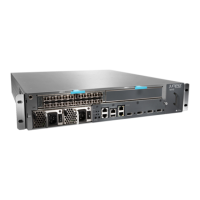The Cable Management System, Cables, and Connectors Overview
Inspect the router cables in the cable management system to ensure that fiber-optic
cables have the proper bend radius and that all cables are organized and securely in
place.
Inspect the PIC cables and connectors to ensure that they transport incoming packets
from the network and transmit outgoing packets to the network.
Inspect the power cables and connectors to ensure that power is supplied to the router.
Inspect the Routing Engine external cables and connectors to ensure that you can connect
external devices to the router.
All Juniper Networks routers have a method of cable management. Although you are not
required to use the cable management system, we recommend that you do so. The cable
management system maintains the proper bend radius for fiber-optic PIC cables. It keeps
installed cables organized, securely in place, and tangle free.
Related
Documentation
Checklist for Maintaining Cables and Connectors on page 351•
M5 and M10 Router Cable Management System
The M5 and M10 router cable management system consists of two vertical pieces, each
with a pair of metal hooks draped in a plastic shield, that attach to each side of the front
of the chassis. (See Figure 181 on page 353.)
Figure 181: M5 and M10 Router Cable Management System
Related
Documentation
Checklist for Maintaining Cables and Connectors on page 351•
M10i Router Cable Management System
The M10 router cable management system consists of racks that attach vertically to
each side of the chassis at the front, as shown in Figure 182 on page 354. Pass PIC cables
through the slots in the racks to keep the cables organized and securely in place, and to
avoid bending optical cables beyond the proper bend radius. The cable management
353Copyright © 2012, Juniper Networks, Inc.
Chapter 12: Maintaining the Cable Management System, Cables, and Connectors

